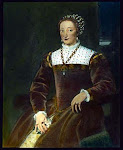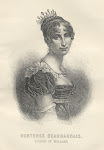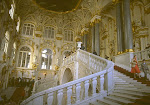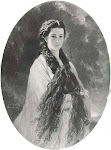

Albert spent much time with the architect Thomas Cubitt reviewing the plans for the new house. It was decided that it was more practical to build a new home instead of adding on to the existing one. Whilst the extensive renovations were undertaken, the Royal family lived in the large, Georgian style home — already there — in which Victoria immediately felt comfortable.Eventually, once ready, the family would move into the new, larger house, the foundation of which was broken on March 16th 1845.
It was an exciting time. Long periods were spent in London and at Windsor Castle, but as soon as they could get away to the Isle of Wight they did. Here they could oversee the plans and watch the construction of their home.Not only was Albert fully aware of every detail of Osborne's progress, he was busily designing the landscape in his mind, and in his letters to family, rendering pictures for them in pen and ink of how the gardens might be laid out.
Everything would have to be just right. The Queen would of course, need a bedroom and sitting room to overlook the magnificence of the blue Solvent, and he wanted to have the children close by as well, so that the environment would be family orientated and intimate. The close knit feeling they were striving for was unusual in comparison to what other royal families had done in the past.
Victoria and Albert chose an Italianate style for their huge, new home, partly because the view reminded the Prince Consort of Italy. The main part of the house was called The Pavilion. A tower was added, as well as a clock, which was scrutinized by Albert.Outside the Pavilion, a terrace was added which they would grow to love.
Many hours were spent there walking amongst the vibrant, colorful plants and flowers, with the waters as a backdrop. Sometimes it was a place to simply relax and converse, and at night time Victoria had the luxury of taking a stroll all by herself, or with Albert, to look at the waters which were sometimes lit up by the moon.
Inside the Pavilion was a massive staircase which traversed many floors, around which were linked many rooms. The guest rooms were situated on the ground floor, included amongst which were the expansive drawing and dining rooms. Pictures of the dining room show that it had light pink walls with splashes of gold and maroon throughout, with heavy mirrors and paintings on the wall. Gleaming, dark furniture was placed under the paintings and heavy drapes hung at the windows, allowing a view of the sea. Enormous, colorful paintings covered every wall of the rooms downstairs, and many statues of the Royal family were placed on stands in the hallways and landings of the house. The hallways in particular took on a classical feeling.
Suites were prepared for the children and their nannies on the third floor. Each room seemed to have windows, almost from floor to ceiling. To protect the children, bars were put across the windows. Just below it on the second floor, for themselves, Victoria and Albert designed a bedroom, sitting rooms and dressings rooms.
The Queen never tired of sitting near her French windows, simply enjoying the scenery or painting watercolor pictures and sketches of the views outside. Painting was a favorite past-time and the pictures she created were light, airy and done in pastel hues.The contents of the rooms were considered comfortable by royal standards, but they were far from opulent. Again, in their private quarters, Albert consumed the walls with his favorite large paintings and a Winterhalter portrait. One luxury they did allow themselves was a bathroom each, with as much hot water as they desired.
The doorways had a unique combination of the letters V and A, intertwined, which adorned the tops. The furniture was all comfortable and picked out personally by Prince Albert. There was chintz on some of the furniture and also at the windows.Victoria loved Windsor Castle, but did note about Osborne “here and dear Windsor, like night and day".
The Queen spent time working on her dispatch boxes and paperwork, while Albert would usually head outside to see about one of his many projects.Victoria was more than pleased that her husband was so happy, noting: "It does one's heart good to see how my beloved Albert enjoys it all, and is so full of all the plans and improvements he means to carry out. He is hardly to be kept at home for a moment." Yes, this was where they belonged. Victoria had no doubt about that.
A wing for the household was also added to the new home. Osborne soon became an impressive building when seen from the sea, as the sailboats and steamships moved about on the Solvent. Sometimes, while watching the dark storm clouds roll in, the Queen could see her yacht, the Victoria and Albert.Her Majesty's carriage, when it arrived, could be pulled up snugly underneath the portico, which was attached to the Pavilion. The exterior of the house was covered in a stucco-like material, made to resemble stone. It was only a 4 hour journey from London to Osborne, making it a wonderful escape for the family and far away from the rigid and formal court life they were used to.
Trips to Osborne caused much anticipation, especially for the Queen, who knew that soon she would be able to spend quiet time alone with her family, and most especially Albert. She loved having him all to herself. Once they left London, at least some of the burdens were lifted from her husband's shoulders and she knew he would relax and she could be herself.Time at Osborne allowed Victoria the intimacy she craved, a level of which her position normally didn't allow. Victoria confided: "Never do I enjoy myself more or more peacefully then when I can be so much with my beloved Albert...follow him everywhere."
It was also during these early years that the Queen swam in the sea for the first time in her life. Heaven! Many years went into the planning and building of Osborne. Guests acknowledged the attention to details within the house and its uniqueness. Visitors were usually comfortable there. It wasn’t long before the family settled themselves into a routine.
Their day usually started at around 7am. Albert got up first and headed to his dressing room where he began to work on his paperwork, focusing on correspondence, current projects or memorandums.Victoria, more relaxed, lounged in her soft, cozy bed for another hour or two. Much of the time she spent there she was pregnant.Sometimes, on warm days, they breakfasted on the terrace with some of the older children. As usual, after they ate, Victoria and Albert strolled through the grounds. Weather permitting, the Queen would sketch or, Albert by her side, spend time with their children. Sometimes they collected shells at the waters edge or explored the property.
The royal children had a large Swiss Cottage, which served as a play house, all of the contents of which were in miniature, even the saucepans.As a treat, Albert would cook his children a surprise: a German meal! He also taught them to garden, each having their own area of land and paid for whatever vegetables they were able to grow.
These were exciting times for the children, some of whom grew to have a lifelong love of the outdoors.Everywhere you looked within this royal home there was a token of love---a piece of a memory---a sprinkle of meaning---and a creation remembered. Truly, the Queen thought, we are living in a dream. It was Victoria’s deepest hope and lifelong desire that the home stay in the family for generations...a place of beloved memories and comfort to her grandchildren and their children.Monarchs have wished for many things, but they do not always possess the power to make a dream come true. Queen Victoria's dream was that Osborne would withstand the torrents of time, going on forever.Sadly, this was one dream which was never destined to be.
















+Mary++Princess+of+OrANGE.jpg)



































.jpg)







.png)













1 comment:
日頃出合いがなくてお困りの方は当サイトをご利用するだけで素敵な出合いが体験できること間違いなし!最高の出合いで最高の恋愛をしてみませんか?
Post a Comment